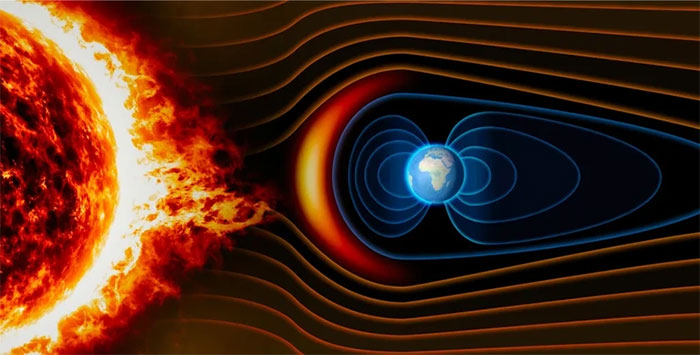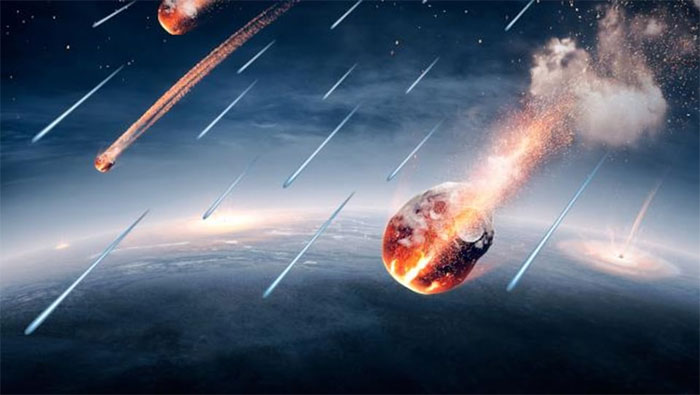The Utopia: Is the Sun the Earth's Water Supply?
The researchers think that the solar wind produces water vapor on the asteroids. When they collide with Earth, they provide a large amount of water.
What is the origin of water on Earth? An international team of scientists has discovered that the Sun is indeed one of the most likely sources of life-sustaining water. Some of the water will be generated by the Solar Wind and carried by asteroids when they collide with Earth.

Some of the water will be generated by the Solar Wind.
Earth is one of the rocky planets of the Solar System. It is the only planet that contains much water, covering about 72% of its surface, or about 366 million square kilometers.
According to the latest estimates, the total volume of water on our planet is about 1,400 million cubic kilometers, to evaluate the giants of water on this planet, scientists have compared the equivalent amount of water that exists. with a cube with sides 1,000 km.
About 4.6 billion years ago, when the Earth was formed, it was just a very hot planet and was constantly bombarded by giant meteorites, carrying water in a vapor state.
When this meteor shower ended 3.9 billion years ago, the Earth's crust cooled and the condensed water became liquid again. Torrential rains flooded our planet.

An illustration of asteroids colliding with Earth carrying water.
Many scientists are sure that some of the water present on Earth is the result of many asteroid impacts. Besides, research by Curtin University (Australia) shows that the amount of water available on Earth can not only be taken in this way, but the Solar Wind is also the source of water supply on Earth.
The solar wind (Plasma wind) is a stream of very hot electrically charged particles in the form of ions, consisting of hydrogen atoms. they are continuously escaping the Sun and scattered in space.
Because of its extreme heat, the particles that make up the solar wind have high thermal oscillation rates that allow them to reach speeds of about 800 km/s, along with masses of up to 1 million tons/s. A very large part of the solar wind is deflected by the Earth's protective magnetosphere.
Without this protection, life on Earth would be impossible. But certain particles from the solar wind have managed to enter our atmosphere. These particles are visible from Earth as aurora borealis.

Auroras are produced by the interaction of charged particles from the solar wind with the planet's upper atmosphere.
On the other hand, the solar wind will also be the source of water generation on the surface of S-type planets, composed mainly of silicates that have crashed into our Earth.
Dust particles of Itokawa

An Itokawa asteroid that the Hayabusa space probe landed and sampled in 2005
On May 9, 2003, the Japan Space Exploration Agency (JAXA) launched the Hayabusa space probe, which landed safely on November 19, 2005 on the surface of the asteroid Itokawa.
This probe is equipped with a minirobot whose mission is to take soil samples from this asteroid and bring it back to Earth. Since then, the researchers have been able to analyze dust particles from Itokawa.
Using a tomographic atomic probe, the high-resolution three-dimensional analytical microscope provides the ability to observe the spatial distribution of atoms that have shown the presence of water. The above is present in dust from the asteroid Itokawa's soil.
This discovery is an important step forward in understanding the early days of our planet and how water supplies formed on Earth. At the same time, it opens up a solution for transporting and storing water for future human space missions.
On the other hand, for the researchers behind this discovery, it's more likely that the process taking place on Itokawa could very well happen elsewhere, on bodies without atmospheres like the Moon.
The ability to collect water from the dust of these space objects is a definite advantage for astronauts. As a result, future probes will not have to take in large quantities of water to meet the needs of people during trips lasting months or years to the limits of the Solar System.
- Vietnamese engineer turns air magic into water
- New material
- Detection of brain feeding amoeba in the US water supply system
- Japan studied building generators from water pipes
- Australia applies new technology to treat wastewater
- Clean water tower
- Uses of the water tower
- Video: Solar energy machine to supply water and Internet
- Infected tap water
- The ice sheet on Mars can provide water for future residents
- Fabric absorbs water from fog
- This bizarre thing has helped sea snakes not drink water for 6 - 7 months.
 Van Allen's belt and evidence that the Apollo 11 mission to the Moon was myth
Van Allen's belt and evidence that the Apollo 11 mission to the Moon was myth The levels of civilization in the universe (Kardashev scale)
The levels of civilization in the universe (Kardashev scale) Today Mars, the sun and the Earth are aligned
Today Mars, the sun and the Earth are aligned The Amazon owner announced a secret plan to build a space base for thousands of people
The Amazon owner announced a secret plan to build a space base for thousands of people